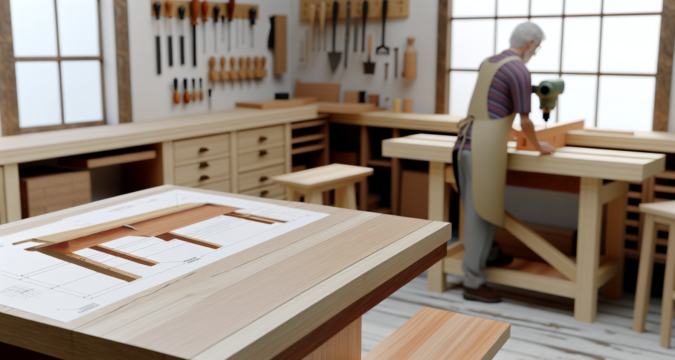
As a child, I fondly remember the first time my dad let me help out in his wood shop. Feeling those wood shavings under my fingers as I learned to safely operate the band saw filled me with such joy and creativity. That early exposure sparked a lifelong passion for woodworking and building things with my hands.
This article provides the best beginner woodworking plans for kids of all ages to similarly engage them in building, crafting, and developing new skills.
| Section | Key Takeaways |
|---|---|
| Benefits of Woodworking for Kids |
|
| Beginner Plans by Age |
|
| Choosing Woodworking Plans |
|
| Ensuring Proper Preparation |
|
| 5 Biggest Mistakes by Adults |
|
Benefits of Woodworking for Kids
Introducing kids to woodworking at a young age offers many developmental upsides beyond just fostering hobbies. Key benefits include:
- Promotes creativity, self-expression, and personal growth
- Develops motor skills and critical hand-eye coordination
- Teaches planning, measuring, spatial reasoning, and problem-solving
- Builds patience, focus, and sense of achievement in finishing projects
- Can spark new lifelong passions, skills, or even future careers
As both an inherently creative yet technical pursuit, woodworking is ideal for nurturing young curious minds.
Beginner Woodworking Plans by Age
The best kid-friendly woodworking plans match the complexity and skills involved with children’s developmental capabilities at various ages.
Ages 3-5
For preschoolers, start with basic introductory builds focusing more on playful interaction than strict woodworking education. Great beginner projects include:
- Simple picture frames to decorate and paint
- Building block stick constructions to let imaginations soar
- Wind chimes made from dowels and assorted hanging objects
The goal should be less about perfection and more about safe exposure to tools, creating a fun activity, and building confidence.
Ages 6-8
As fine motor skills improve, elementary school-aged kids can start to undertake more hands-on woodworking using child-safe hand tools. Some solid starter projects:
- Bird houses bring wildlife into the backyard
- Toolboxes let kids carry around their quarry like little woodworkers
- Coat or cubby racks teach measuring, drilling, and structure
With each creation, kids will enjoy the growing sense of achievement while learning.
Ages 9-12
For pre-teens and tweens, consider more complex builds that start to mirror “real” woodworking and exercise problem-solving faculties. Advanced examples include:
- End-grain cutting boards make lasting kitchen tools
- Jewelry or trinket boxes let them store prized possessions
- Desk organizers help build order from mess
Give explicit guidance but room for self-directed building at this age as kids start developing more confidence and capability with both tools and personal responsibility.
Choosing Woodworking Plans
In picking child-appropriate projects, keep these guidelines around complexity, skills development, and safety in mind:
- Match initial plans to the child’s unique interests if possible
- Focus on building key skills like measuring, sawing, nailing, and drilling
- Start with easy wins to slowly build confidence without frustration
- Ensure adult supervision at all times for use of advanced power tools
- Buy kid-sized woodworking tools adapted for smaller hands
Ensuring Proper Preparation
Properly setting up tools, workstations, and procedures makes for safe, engaging, and successful kids’ woodworking activities. Be sure to:
- Organize work areas to limit distractions and prevent accidents
- Offer clear safety precautions around sharp edges or chemicals
- Have all materials and hardware pre-purchased and prepared
- Clean up workspaces after each session
5 Biggest Mistakes Adults Make
Even informed parents and educators may undermine positive woodworking experiences for children by:
- Not providing enough upfront guidance and instruction
- Pushing kids prematurely into overly complex builds
- Allowing unsupervised use of dangerous power tools
- Failing to designate organized workstations
- Getting overly fixated on final products rather than acquired skills
Focusing on Skills and Learning
Rather than perfect museum-worthy creations, adults should view children’s woodworking through the lens of skill-building and organic learning. Finished projects will be imperfect but can represent immense personal growth.
Start Introducing Woodworking Today
The most significant takeaway should be that woodworking can provide immense benefits as part of any child’s development starting at a very young age. With the right plans tailored to appropriate skill levels, kids can start constructing, creating, learning, and unlocking new life passions.
So don’t wait – introduce a child in your life today to the creativity and reward of woodworking! Start easy, focus on safety, practice patience, but above all, just have fun making sawdust. The results might surprise and inspire you both.
Frequently Asked Questions
Q: At what age can kids start basic woodworking?
A: With supervision and safe practices, children as young as 3 years old can start building enjoyment, confidence and basic skills through simple woodworking crafts and play.
Q: What safety steps should I take with kids in the wood shop?
A: Proper preparation is key including organizing workstations, establishing rules around tools, ensuring personal protective equipment, and supervising at all times.
Q: Should I correct all the imperfections in my child’s wood projects?
A: Avoid over-criticism – small imperfections should provide learning experiences, not frustration. Praise effort and growth while guiding gently.
Q: Can woodworking really lead to viable future careers?
A: Yes! Skilled trades like carpentry, woodworking, construction, and artisanal crafts provide meaningful, well-compensated careers for many.
Q: What are simple starter hand tools every kid should have?
A: Great first toolsets include kid-sized safety gloves, goggles, a small hand saw, plastic hammer, wood glue, sand paper, and a mini screwdriver.
Q: Is it safe for kids to use power drills or saws?
A: No! Dangerous rotating power tools require adult supervision until at least age 12+ when proper discipline and safety behavior is assured.
Q: Where can I find more woodworking project ideas?
A: This article links to an overview of other woodworking projects suitable for hobbyists of all ages and skill levels!
Below are three external links that could be relevant to this article:
https://diyprojects.com/woodworking-projects-for-kids/
https://www.youtube.com/watch?v=LnuNu1cpjC4
https://www.anikasdiylife.com/woodworking-project-ideas-for-kids/

